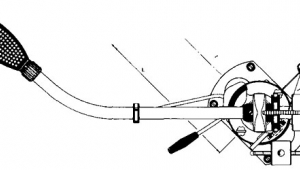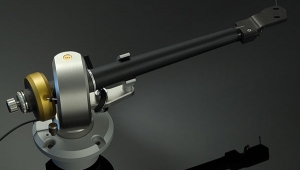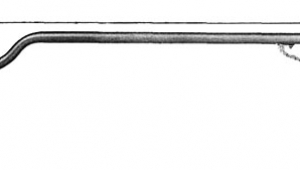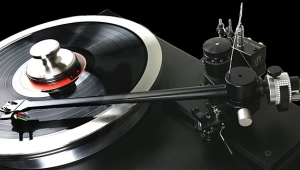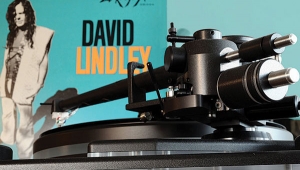| Columns Retired Columns & Blogs |
Graham Model 1.5 tonearm Follow-up, the 1.5-T/C part 2
The first thing I examined was the change from brass to tungsten counterweights—an upgrade which can be done easily by you. Just unscrew the old weights and screw in the new ones. But be careful when you screw in the new weights to make sure you have the screw thread seated properly—it's very easy to strip the plastic threading if you screw it in wrong. I traded my old set of brass weights in well over a year ago, so Bob Graham sent me a set of older ones so I could compare them in a tightly controlled A/B situation.
Footnote 4: I swear I'm not making this stuff up. I'm pretty skeptical when manufacturers tell me that cable needs to be broken-in. Yeah, right. What's to break-in? The Cardas cable hadn't been used for about two months, and it sounded pretty rank when I first installed it. A few minutes of signal passing through it resulted in a definite change. Honest—and I was sober.—Steven Stone
First thing you'll notice about the tungsten weights is how much heavier they are than the brass. The ergonomic advantage of this extra weight is that you don't have to unscrew each weight as much to change the azimuth. If your cartridge does require a great deal of correction, it's probably because you have a brass screw on one side and a lightweight aluminium screw on the other side. Make your life easy—use matching screws.
While I would hesitate to call the sonic change with the tungsten counterweights dramatic, bass was better defined and had slightly more low-end extension. The brass counterweights made lower frequencies sound a bit soft and thick in comparison. Tori Amos's piano pedaling on "Pretty Good Year," from her Under the Pink LP (East/West 7567 825671), sounded more distinct and had superior definition with the tungsten weights. The tungsten weights also seemed to offer slightly better micro- and macrodynamics. The dynamic subtleties of Robin Jeffries' guitar on the "Creole Medley," from the Chesapeake Minstrels' Creole Belles—Music on the Mississippi from Stephen Foster to Scott Joplin (Hyperion A66069), were better articulated. Worth the extra $250? Yes, I'd say so.
According to Bob Graham, the SW-3 ceramic armtube is the product of many months of work. The time was well-spent. The SW-3 sounded noticeably less resonant than the SW-2, apparent even when I tapped on the armtube with a pencil. With the SW-2, each tap went "ting"; with the SW-3, I got a dull thunk. The SW-3 is so nonresonant that even wrapping it in the material from Sumiko's Analog Survival Kit made no difference in its performance. With the SW-2, the arm-wrap definitely changed tings to thunks; with the SW-3, you needn't bother.
How did this reduced armtube resonance translate to music? With some cartridges, you may not like what you hear. No longer did the arm add any warmth or bloom to a cartridge's midrange. The van den Hul MC-1 sounded cooler and a bit more mechanical mounted on the SW-3 compared to the SW-2. Conversely, the Dynavector XX-1L came alive when mounted on the SW-3. It had greater midrange clarity, increased transient speed, and better definition at the frequency extremes. The Fidelity Research/van den Hul FR-1 Mk.III also sounded faster in the SW-3, but still retained its succulent midrange. Also, drastic harmonic differences between carts were reduced by the SW-3's lack of resonance.
While all cartridges retained their personalities, the differences between them primarily involved more subtle nuances, such as soundstage presentation and low-level resolution, rather than dramatic differences in harmonic balance. My overall impression of the SW-3 was that its lack of resonances allows cartridges to be themselves without the armtube figuring into the equation. Less armtube resonance translates into more neutral presentation of the cartridges' intrinsic personalities.
If you're still using the original IC-2 junction box to connect your arm to your phono preamp, I strongly suggest you get rid of it. Replacing the box with the IC-30 or any other high-quality one-piece cable—and in the process eliminating a pair of RCA connections that carry a low-level, pre-equalized phono signal—improves the Graham arm's performance immensely.
The IC-30 cable in place of the IC-2 dramatically decreased the level of background noise, and delivered much better inner detail. The difference was like exchanging a cartridge on its last legs for a new, fully-broken-in sample. I know you won't be able to have as much fun switching premium tonearm cables, but there are more enjoyable ways to spend your time—like listening to music. If you must use a junction box, you could try the new IC-2.5, which has improved hardware. But if you can, and if you want to get the best performance from your Graham arm, jettison the boxes.
Giggles
Just for giggles I compared the Graham IC-30 to the $595 Cardas Hex 5 cable I'd been using. The IC-30 is quite flexible, and is thus easily manipulated around tight corners. The Cardas has the flexibility and weight of garden hose at 20 degrees F. The Cardas is definitely a bad choice for owners of delicately balanced Linns and Oracles. The VPI TNT Jr. doesn't care what cable you use, since the only way to move it once it's set up is with a crowbar.
At first the Cardas cable sounded noticeably harsher than the IC-30; but after about 10 minutes of break-in, it lost its harsh edge and became more vivid, with slightly better definition and spatial rendition (footnote 4). The IC-30's presentation sounded very smooth and relaxed, and, compared with the Cardas, somewhat laid-back. With good recordings, such as Joel Cohen's and the Cambridge Consort's Songs of a Traveling Apprentice (Titanic TI-19), I preferred the Cardas, which allowed a little more of the subtle details and intricate musical textures to emerge from the mix. The lute, especially, sounded faster, with better apparent transient response and sparkle. The IC-30 rendered Alvin Lee's weirdly EQ'ed voice on Ten Years After's Ten Years After Undead (Deram DES 18009) slightly more tolerable, while sacrificing little in the way of clarity.
I'm an information freak, so after a few hours of alternating between the IC-30 and the Hex 5, I chose the latter, which costs $150 more than the IC-30. The Hex 5 may not work if your turntable is delicately spring-balanced. But in my system, it was the way to go.
Summary
"Balanced" was the word that kept popping up in my listening notes about the overall sound of the Graham Model 1.5-T/C tonearm. It occupies a sonic middle ground between the Clearaudio/Souther TQ-1 and Wheaton Triplanar arms. The Graham has more low bass than the Clearaudio, is much easier to set up, and will work with a wider variety of cartridges; but it still offers slightly less inner detail. Compared to the Wheaton, the Graham has more inner detail, slightly better midrange neutrality, but less mid- and low-bass bloom.
As to which arm is "best," I find the question repugnant. Who am I—or any reviewer, for that matter—to tell you what's best for you? My job is to explain as clearly as possible the intrinsic strengths and weaknesses of a product so you can make an informed decision.
The Graham 1.5-T/C represents one man's elegant solution to the complex problems of tonearm design. It's ideal for audiophiles who have more than one cartridge to which they're addicted. The Graham is also the easiest arm I've ever used to set up and properly adjust. It will work easily on any turntable, from the most delicately sprung to the most rigid. I've owned a Graham for over five years, and have used it on several different turntables, installed scores of cartridges on its armtubes, and have never found it wanting in reliability or neutrality. In its latest incarnation, the 1.5-T/C certainly merits its designation as a Class A product.—Steven Stone
Footnote 4: I swear I'm not making this stuff up. I'm pretty skeptical when manufacturers tell me that cable needs to be broken-in. Yeah, right. What's to break-in? The Cardas cable hadn't been used for about two months, and it sounded pretty rank when I first installed it. A few minutes of signal passing through it resulted in a definite change. Honest—and I was sober.—Steven Stone
- Log in or register to post comments


